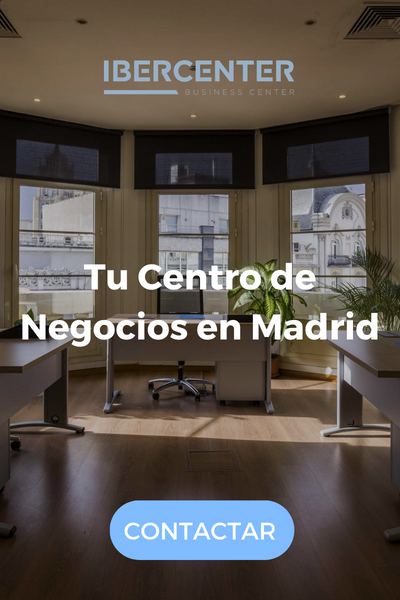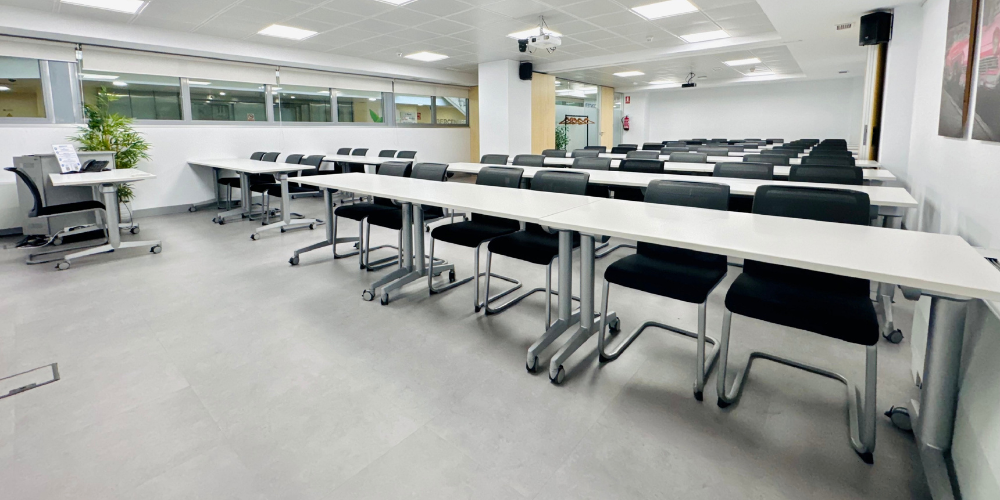For centuries, the concept of workspace was linked to the idea of the traditional office, a rigid and hierarchical environment that responded to the needs of an era marked by stable business structures and uniform work methodologies. In these environments, functionality took precedence over any other aspect. The offices were organized around individual desks, bulky filing cabinets and spaces reserved exclusively for managers, reinforcing a clear distinction between the different roles within the company.
With the advent of the Industrial Revolution, workspace began to expand beyond offices, adapting to factories and mass production environments. However, the model was still rigid and focused on productivity at any cost, leaving aside aspects related to employee well-being or collaboration between teams. The modern offices that began to emerge in the mid-twentieth century, influenced by designs such as “Taylorism“, organized space efficiently, but without taking into account comfort or human relationships.
The real turning point came at the end of the twentieth century and the beginning of the twenty-first with the irruption of technology. The emergence of personal computers, e-mail and, later, the internet, marked a radical change in the way we work. Companies began to realize that the old closed and hierarchical offices no longer adjusted to the needs of an increasingly dynamic workforce.
The shift to open offices, such as the concept of “open spaces,” sought to foster collaboration and reduce physical barriers between employees. While this model was initially successful, it also highlighted issues such as a lack of privacy and constant noise.
At the same time, the new generations of workers began to demand more than just a place to meet a schedule. They wanted spaces that favored creativity, connection between people and the possibility of reconciling professional and personal life. This is where the traditional model began to lag behind and new formulas emerged. Coworking, born as a response to the need to share resources and lower costs, soon evolved to become a much richer and more complex option, which not only offered a physical place, but a community and an experience.
As companies have adopted more flexible structures and adapted to globalization, workspaces have also had to evolve. Needs have changed radically: it’s no longer just about having a desk and a phone, but about having an environment that allows you to work from anywhere, with access to advanced technology and areas designed for different types of tasks. Coworking has established itself as a solution that, in addition to offering this flexibility, encourages collaboration between professionals from different sectors, allowing the creation of synergies that would hardly arise in a conventional office.
In short, the journey of workspaces reflects how companies and workers have had to adapt to a constantly changing world. What was once a static environment, designed exclusively for production, is now understood as a dynamic space that must inspire, connect and provide the necessary tools to grow. This evolution has not only transformed the physical appearance of offices, but also the way we understand work, putting the individual and their needs at the center of the equation.

The impact of technology on the transformation of workplaces
Technology has been the most significant catalyst in the transformation of workplaces over the past few decades. Looking back, it’s clear how digitalization has changed not only the way we work, but also the environments where we work. This process has allowed workspaces to evolve from being physical places limited by rigid schedules and analogue tools, to becoming dynamic, flexible environments adapted to the needs of an interconnected world.
Digitalization, as a driver of change, has eliminated geographical barriers and has greatly expanded the possibilities for companies and professionals. Where once a shared physical space was essential to coordinate tasks and projects, today an internet connection is enough for teams located in different parts of the world to work in perfect synchrony. This has completely transformed the traditional concept of the office, giving way to a model in which the physical location is secondary to the ability to connect in real time with technological tools.
Among the main innovations that have marked this transformation are remote connection platforms. Thanks to technologies such as VPNs, access to cloud servers, or video conferencing applications, workers can perform their duties from anywhere, maintaining a level of collaboration and productivity similar to what they would have in a traditional office. Tools such as Zoom, Microsoft Teams or Google Meet have been crucial in consolidating the hybrid work model, allowing fluid virtual meetings and constant communication, even when teams are dispersed.
Collaborative software has also played a key role in this revolution. Apps like Slack, Trello, Asana, or Notion have redefined the way companies manage projects and communicate internally. Not only do these platforms make it easier to organize tasks, but they also foster a more agile and transparent work culture.
Cloud-shared documents, for example, allow multiple people to work simultaneously on the same file, eliminating the need for endless email chains with versions attached. This has saved considerable time and increased efficiency in project execution.
Automation, meanwhile, has radically changed the work landscape in terms of productivity and accuracy. Processes that previously required hours of manual work can now be completed in a matter of minutes thanks to tools such as RPA (Robotic Process Automation) or algorithms based on artificial intelligence.
Not only has this reduced the burden of repetitive tasks for employees, but it has also allowed companies to reallocate their resources towards strategic and creative areas. In addition, real-time data analytics technology has improved the ability of businesses to make informed decisions, thereby optimizing their performance and adapting quickly to market changes.
Workplaces, in this context, have had to adapt to these technological innovations to stay relevant. Modern offices are no longer just places where a group of people gather, but environments fully equipped with the technological infrastructure necessary to support these new ways of working. From desks with built-in charging stations to smart meeting rooms with state-of-the-art video conferencing equipment, everything is designed to maximize connectivity and efficiency.
Ultimately, technology has not only transformed workspaces into functional terms but has also changed the way we understand work itself. It has allowed companies to be more agile, workers to enjoy greater flexibility and the barriers between face-to-face and remote to be blurred. This transformation, far from being static, continues to advance, propelling workplaces towards an increasingly digital, connected and collaborative future.
The rise of flexible spaces: coworking and shared offices
In recent years, we have witnessed a significant transformation in the way we think about the workplace. The traditional fixed office model, with long rows of desks and closed offices, has led to a new way of understanding work environments, more adapted to the needs of today’s world. This change has been led by the rise of flexible spaces, especially coworking and shared offices, which have revolutionized not only the aesthetics and functionality of workplaces, but also the way in which companies and professionals interact and collaborate.
Coworking, which originally emerged as a simple solution to share resources and lower costs, has evolved to become a highly demanded formula, especially among startups, SMEs and self-employed professionals. This model allows start-ups to access modern, fully equipped facilities without having to take on the exorbitant costs and long-term commitment involved in renting or buying a traditional office.
For startups, which often operate on tight budgets and under the need to grow quickly, having a space that offers total flexibility is essential. SMEs, for their part, also find in these spaces the opportunity to establish themselves in privileged locations without bearing the costs associated with their own offices.
The appeal of flexible environments lies in their ability to adapt to changing business dynamics. Unlike fixed offices, where everything is structured for uniform and linear use, flexible spaces are designed to respond to multiple needs. In a coworking environment, a company can use a meeting room equipped with state-of-the-art technology in the morning and then move to a common area for more informal brainstorming sessions.
This versatility is especially useful for expanding businesses, which may need additional space at certain times or reduce their facilities depending on their projects.
In addition, these spaces encourage a more collaborative and creative way of working. The possibility of sharing a place with professionals and companies from different sectors opens the door to connections that would otherwise be difficult to generate. A freelancer in the field of graphic design can sit next to a technology development team, and from that interaction emerge a joint project that benefits both parties. Coworking is not only a logistical option, but also a platform that promotes networking and the exchange of ideas.
Another of the great benefits of these environments is the focus on the well-being of workers. Unlike traditional offices, which are often impersonal and uninspiring, coworking spaces are often designed with comfort and productivity in mind. From well-equipped rest areas to cafes, terraces or even yoga rooms, every detail is designed to make users feel at ease and can concentrate on what really matters: their work.
This approach not only improves the daily experience of employees, but also increases their performance, as a pleasant and stimulating environment has a direct impact on motivation and creativity.
Contractual flexibility is another of the great attractions of this model. Companies can access these spaces without having to tie themselves to long-term leases, allowing them to react quickly to market changes. For an SME that is just starting its activity, signing a five-year contract for a fixed office can be an unnecessary burden. On the contrary, a coworking space offers them the possibility to scale according to their needs, either by expanding or reducing their presence. This agility is key in today’s competitive business environment.
Finally, flexible spaces are redefining the concept of professionalism. Having an address in a well-located building, along with services such as personalized telephone attention or mail management, provides a more professional and consolidated image, even for smaller or newly created businesses. These types of details, which may seem secondary, make the difference when it comes to project confidence and seriousness in front of customers or investors.
In short, the rise of coworking and shared offices is not a passing fad, but a response to the real needs of today’s companies and professionals. Flexibility, the possibility of making valuable connections and a design that puts the user at the center make these spaces an ideal solution for a constantly evolving world of work. Adapting to this new reality is not only a matter of comfort, but of competitiveness.
The pandemic as an accelerator of change
The COVID-19 pandemic marked a turning point in our understanding of work. What initially seemed like a temporary measure to respond to a global health crisis became the starting point for a structural change in the workplace. Teleworking, which until then had been a minority model adopted only by certain companies and professionals, became the norm for millions of workers around the world. This forced experience caused both companies and employees to reconsider what was necessary to perform their roles, questioning the reliance on physical spaces and rigid models of face-to-face work.
During the first months of the pandemic, the priority was adaptation. Companies had to implement, in record time, technological solutions that would allow their employees to work from home. Video conferencing platforms, project management tools, and remote access to business systems became indispensable. While this process was fraught with challenges, it also highlighted something important: many tasks could be performed effectively without the need to be in an office. This discovery was the catalyst for a change in mentality, both in business management and in the workers themselves.
Remote working not only proved to be viable but also offered undeniable advantages. Employees value the flexibility of being able to organize their time more autonomously, eliminating the long commutes that characterize working life in large cities. On the other hand, companies realized that they could reduce certain costs associated with maintaining offices, without necessarily affecting productivity. However, this modality was not without challenges.
The lack of face-to-face interaction began to generate distance between teams, and for many employees, working from home continuously implied problems such as the difficulty of separating personal life from the professional sphere or social isolation.
From this context arose the need to look for a model that combined the best of both worlds: hybrid work. This approach, which alternates days of face-to-face work with remote workdays, has been adopted by a growing number of companies as a solution to adapt to new employee expectations, while maintaining cohesion and corporate culture.
The hybrid model allows you to enjoy the flexibility that teleworking brings, without giving up the benefits of sharing a physical space, such as the spontaneous creativity that arises in informal conversations or the ability to solve problems more quickly in face-to-face meetings.
However, this transition to a hybrid model poses new needs and challenges in the workplace. Offices are no longer places where employees spend their entire day, but strategic meeting points designed to foster collaboration and interaction. This has driven a transformation in the design of work environments, which now prioritize flexibility and adaptability. Many companies are choosing to reduce the size of their traditional offices and bet on solutions such as coworking spaces, where they can access meeting rooms, collaborative areas and specific services depending on their specific needs.
In this new scenario, it is essential to find a balance between face-to-face and remote work. Remote work, while convenient and flexible, cannot completely replace the human connection and sense of belonging that comes from sharing a physical space with colleagues. On the other hand, returning to an exclusively face-to-face model would be perceived as a setback by those employees who have already experienced the advantages of working from home. Companies that manage to find this balance will not only increase employee satisfaction but also improve their ability to retain talent in an increasingly competitive labor market.
The pandemic accelerated a change that would probably have come anyway over time. It forced us to rethink what it really means to work, what the purpose of an office is, and how we can leverage technology to create more efficient and humane work environments. Now, the challenge is to consolidate these advances and build a work model that is not only functional but also responds to people’s expectations and the demands of a world in constant transformation.
Ibercenter, the space you need
In an ever-evolving business world, finding the right workspace has become a key strategic decision for any business. At Ibercenter we understand that each company has unique needs, and that is why we have designed a range of flexible offices and spaces that adapt to the requirements of freelancers, startups, SMEs and large companies.
We are much more than a place to work: we are a partner that accompanies you in the growth of your project, providing you with everything you need to focus on what really matters, your business.
Our experience of more than 25 years in the sector has allowed us to perfect a model that combines functionality, flexibility and personalized attention that makes the difference. Our centers, strategically located in three of the best areas of Madrid – Azca, Gran Vía and Velázquez – not only offer a privileged location, but are designed to project a professional and exclusive image of your company. From fully equipped private offices to shared spaces for coworking, every corner is designed to inspire productivity, creativity and, above all, comfort.
At Ibercenter we know that flexibility is key in today’s business environment. That’s why our contracts are tailored to your needs, with no upfront investment requirements or long-term commitments that limit your ability to maneuver. You can have a custom-made space, with the possibility of expanding or reducing it according to the evolution of your activity. This approach allows you to focus on your goals while we take care of the operational details, from space management to administrative services.
One of the added values that distinguishes us is our team, always ready to offer you an impeccable service. We understand that personalized attention makes the difference and, therefore, our receptionists manage your calls, correspondence and any need that arises in your day to day. Having someone answer the phone on behalf of your company, or help you coordinate meetings and events, not only improves your productivity, but also reinforces the professional image you convey to your clients and partners.
In addition, our facilities are equipped with the latest technology so that you can work with complete peace of mind. From video conferencing systems and high-speed connections to common areas designed to encourage networking, every detail is designed to make your work easier. And all this with access 24 hours a day, seven days a week, because we know that your schedule is set by you.
Last but not least, at Ibercenter we care about offering an environment that combines functionality and well-being. Our spaces are designed with your comfort in mind, with ergonomic furniture, natural light and rest areas that encourage you to disconnect when you need it most. Working in a pleasant environment not only improves your day-to-day life but also contributes to increase your performance and creativity.
In short, Ibercenter is much more than an office. It is the place where your company can grow, surrounded by services that make your day-to-day life easier and a professional community that enriches your activity. If you are looking for a flexible space, in an unbeatable location and with all the necessary amenities for the success of your business, at Ibercenter you will find the perfect solution. Because in today’s competitive world, we know that every detail counts, and we’re here to make sure every single one of them lives up to your expectations.
Conclusion
The workplace has always reflected business and social evolution. Throughout history, its design, structure, and functionalities have changed to adapt to the needs of each era, and today it is no different. In a world where technological transformations and employee demands are advancing at a dizzying pace, workspaces have become more than just a place to perform tasks. They are now strategic environments that directly influence the productivity, well-being and success of companies.
The evolution of the workspace is intimately linked to the demands of the market and the expectations of society. In recent years, we have seen how companies have embraced hybrid models, prioritizing flexibility and work-life balance. This is not just a fad, but a response to structural changes in the way we understand work. Technology will continue to play a key role in this transformation, enabling workers to collaborate from anywhere and forcing offices to reinvent themselves as more creative, social and dynamic meeting points.
But the changes are not limited to technology. We are also witnessing a growing interest in sustainability and environmental impact. The workspace of the future will need to be increasingly environmentally friendly, not only in terms of energy efficiency, but also in the design of healthy environments that promote the physical and mental well-being of employees. Natural light, recyclable materials, and adequate rest areas are aspects that companies cannot ignore if they want to attract and retain talent in an increasingly competitive market.
Choosing the right work environment is no longer simply a matter of budget or location. It’s a strategic decision that can make all the difference in a company’s ability to innovate, collaborate, and grow. A well-designed workspace not only improves productivity, but also strengthens company culture, fosters team cohesion, and projects a professional image to customers and partners. Companies that understand the importance of this aspect are the ones that are better able to adapt to market changes and successfully position themselves in their sector.
The transformation of workplaces will continue in the coming years, driven by new technologies, generational shifts and a growing focus on well-being and sustainability. Companies that know how to adapt to these trends will not only survive, but thrive, because they will have understood that the workplace is not simply a physical place, but a reflection of their ability to innovate, evolve and respond to the needs of their employees and customers.
In this context, investing in a suitable workspace is not a luxury, but a necessity. It’s not just about offering convenience or access to modern tools, it’s about creating an environment that inspires people, allows them to be their best, and ultimately drives business growth. In an ever-changing world, choosing a workspace that is up to today’s demands is one of the most important decisions a company can make. A space that not only adapts to the present, but is prepared for the challenges of the future, is the foundation on which business success is built.
Business center in Madrid | Flexible offices in Madrid




